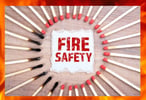Fire Retardant Plastic Sheeting- Here's what you need to know!
What is fire retardant?
A fire retardant is a substance that is used to reduce or slow down the spread of fire. It can be a chemical, a material, or a physical barrier. Fire retardants are used in a variety of applications, including building materials, textiles, and coatings. Fire retardants work by providing a barrier between the combustible material and the fire, and by releasing a chemical that slows down the burning process.
What is Fire/Flame Retardant Plastic Sheeting?
Fire retardant plastic sheeting is a type of plastic material that has been designed to resist burning and reduce the spread of fire. It is used in a variety of applications, including the building and construction industries, as well as for safety in hazardous areas. It is also used for insulation and protection against heat and moisture.
One type of fire retardant plastic sheeting is made from polyvinyl chloride (PVC), which is a synthetic plastic material. PVC is durable, lightweight, and non-toxic, making it an ideal choice for many applications. It is also resistant to a variety of chemicals, which makes it an excellent choice for use in hazardous areas.
Polyethylene is another kind of plastic that can be manufactured to be fire retardant when special additives are added to the film. The flame retardant plastic sheeting can be white, black or other colors.
One of the key advantages of fire retardant plastic sheeting is its ability to provide superior fire safety. It is designed to resist burning, so it can help to slow the spread of fire in the event of a fire. It can also help to reduce the amount of smoke and toxic fumes produced by a fire, which can help to reduce the risk of smoke inhalation. This is especially important in areas such as hospitals, schools, and other public facilities, where people could be at risk of smoke inhalation.
Fire retardant plastic sheeting may provide insulation. It is designed to act as a barrier between the heat and the environment, diminishing some of the heat from transferring to the environment. This is especially important in areas such as industrial facilities, where temperatures can be high and the risk of fire is significant.
The third key advantage of fire retardant plastic sheeting is its ability to provide protection against moisture. It is designed to resist water absorption, which can help to reduce the risk of water damage in the event of a fire. This is especially important in areas such as hospitals, schools, and other public facilities, where water can be an issue during a fire.
The fourth key advantage of fire retardant plastic sheeting is its resistance to chemicals. It is designed to resist the effects of many chemicals, including those found in cleaning products, which can help to reduce the risk of chemical exposure in the event of a fire. This is especially important in areas such as industrial facilities, where chemical spills can be an issue.
The fifth key advantage of fire retardant plastic sheeting is its ease of installation. It is designed to be easy to install and does not require a lot of specialized tools or equipment. This makes it an ideal choice for many applications, as it can be quickly and easily installed with minimal effort.

Applications for Fire Retardant Plastic Sheeting
There are many various applications and uses for flame retardant plastic sheeting. One of the major uses for this film is construction sites. According to the NFPA, "Local fire departments responded to an estimated average of 4,300 fires in structures under construction per year in 2016 through 2020. These fires caused an average of five civilian deaths, 62 civilian injuries, and $376 million in direct property damage annually."
Applications for flame retardant plastic sheeting include:
- Roofing membrane
- Haunted House Attractions
- Wall liners
- Shipping Containers
- Attic insulation
- Bags and tubing
- Basement walls
- Drywall partitions
- Sheds
- Architectural vapor retarder in walls, ceilings and in roofing systems
- Outdoor shelters
- Industrial enclosures
- Automotive components
- Cargo Covers
- Structural components
- Boats
- Pools
- Golf courses
- Playgrounds
- Building construction
- Ventilation systems
- Fire curtains
- Fire doors
- Fireplaces
- HVAC systems
- Fire-resistant ducts
- Aircraft interiors
- Military applications
- Marine applications
- Fire-resistant signage
- Room dividers
- Ceiling tiles
- Fire-resistant flooring
- Refrigeration liners
- Electrical insulation
- Fire-resistant gaskets
- Fire-resistant tanks
- Wall systems
- Fire-resistant cabinets
- Acoustic insulation
- Tunnel liners
- Data centers
- Telecommunications systems
- Industrial ovens
- Flammable liquid containers
Fire Rating Classification Explained:
Fire rating classifications are a way to measure the ability of a building material or assembly to contain and resist the spread of fire. It also indicates the smoke produced by the material. This is determined by a flame spread index.
Classifications include
- Class A – Class A fires involve solid materials like wood, trash, and textiles. Ordinary combustibles. These fires are most familiar to us and are the most easily extinguished.
- Class B – Class B fires involve flammable liquids like gasoline, alcohol, diesel, or oil (not cooking oils). The volatility of the fuel source makes them more difficult.
- Class C – Class C fires involve electrical components and equipment as fuel sources. This includes fires started by faulty wiring in walls, circuit breakers, and appliances.
- Class D – Class D fires involve metals. In rare instances, metal can ignite. This is primarily a problem in lab environments, as well as certain production and other industrial processes.
- Class K – Class K fires involve cooking oils and fats. Sometimes they are lumped in with Class B, but they are their own beast. These fires are typically started when someone leaves a pan unattended.
A materials fire rating is determined by testing the material and measuring its ability to resist fire as well as its ability to contain the fire. The higher the rating, the more fire-resistant the material. Fire ratings are important when considering building materials for construction and renovation, as they help ensure the safety of occupants and property.
Organizations involved with fire safety:
NFPA- The National Fire Protection Association is a global self-funded nonprofit organization, established in 1896, devoted to eliminating death, injury, property and economic loss due to fire, electrical and related hazards. This organization is known as a codes and standards organization. They have over 300 codes and standards which are designed to minimize the risk and effects of fire by establishing criteria for building, processing, design, service, and installation around the world.
NFPA 701: Standard Methods of Fire Tests for Flame Propagation of Textiles and Films
This standard establishes test methods to assess the propagation of flame of various textiles and films under specified fire test conditions.
ASTM E84 - This is the Standard Test Method for Surface Burning Characteristics of Building Materials. The test reports the Flame Spread index and Smoke Developed index of the tested product.
What is the Top-Selling thickness of Plastic Sheeting?
Visit the six mil plastic sheeting page to see the top selling 6 mil films.
6 mil plastic is the most common thickness sold today but not necessarily by volume.






